Is Automation in Call Centers Worth the Investment in 2025
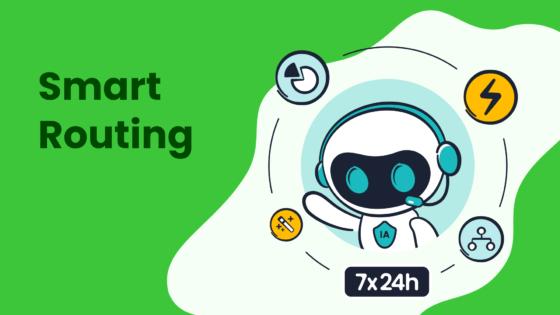
Yes, automation in call centers is worth the investment in 2025 for most organizations. Companies now see impressive cost savings and faster return on investment. Automation enables up to 95% cost reduction for routine tasks and improves customer experience with rapid response times. By 2025, 80% of companies will use AI chatbots, and 95% report significant savings.
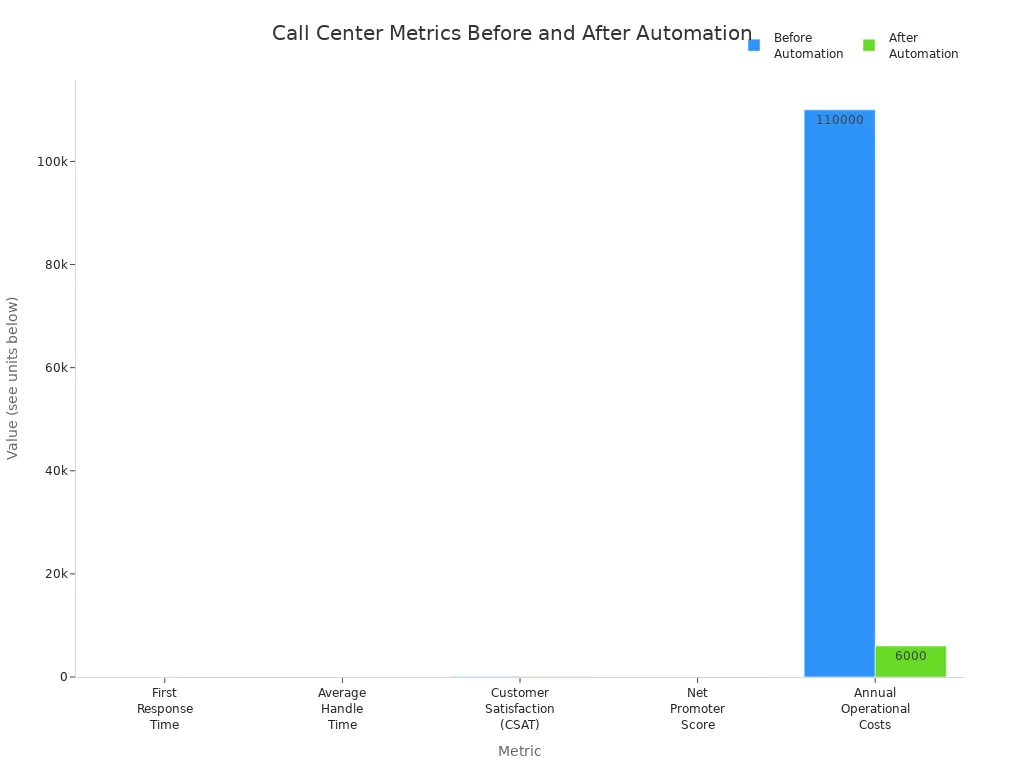
Sobot AI leads with advanced solutions like Sobot call center, helping businesses unify channels and maximize savings, efficiency, and customer experience.
Automation in Call Centers 2025

Technology Trends
Call center automation in 2025 brings a wave of new technology trends that transform how companies serve customers.
- AI now works alongside human agents, summarizing calls, automating post-call tasks, and improving quality management.
- Agentic AI and robotic process automation help solve problems before they grow, reducing the workload for staff.
- Natural language processing and behavioral analytics give companies deep insights into customer needs.
- Predictive analytics help forecast call volumes and plan resources.
- Omnichannel support ensures customers get seamless service across phone, chat, email, and social media.
- Hyper-personalized customer experience becomes possible with real-time analytics.
- Voice biometrics and advanced security protect customer data and speed up authentication.
- Augmented reality starts to help with visual support, making problem-solving faster.
- Cloud adoption grows, offering flexibility and easy integration.
- Self-service options let customers solve simple issues on their own, which reduces agent workload.
- Companies invest in better tools and training for agents, boosting morale and retention.
Sobot Solutions
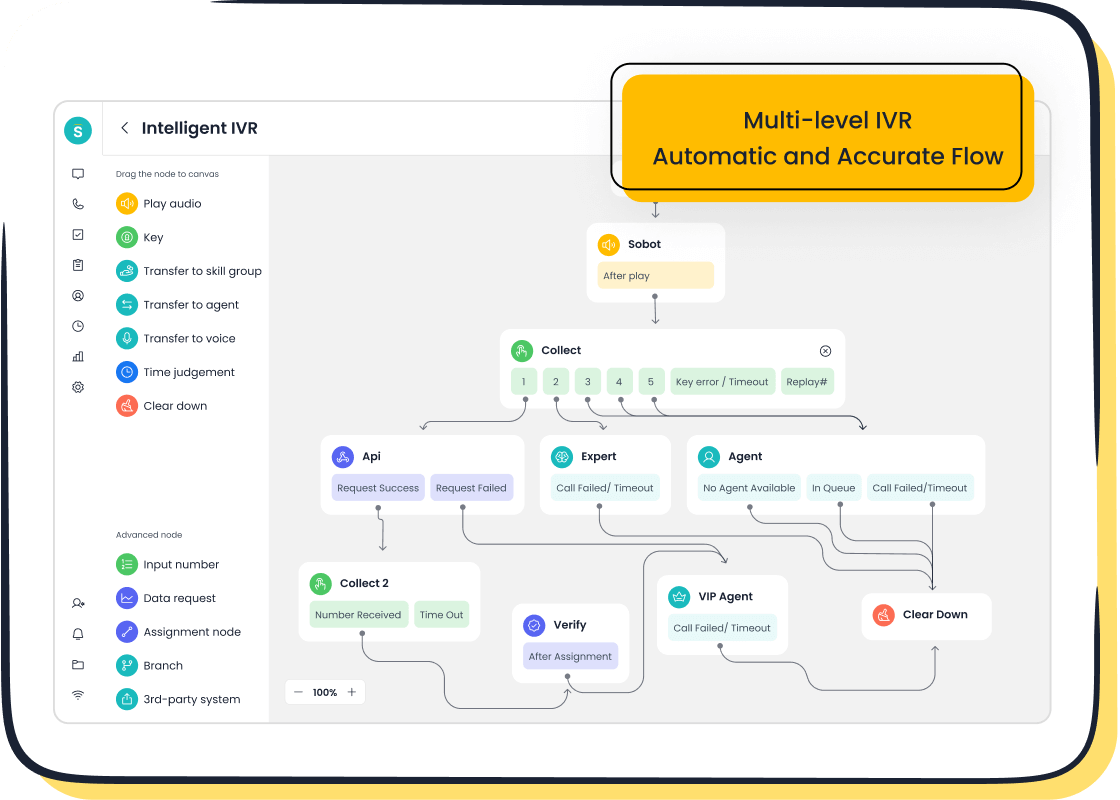
Sobot stands out in the call center automation space by offering advanced Voice/Call Center and Omnichannel Solutions. Sobot’s platform automates customer service operations, reduces response times, and improves ticket resolution rates. The Voice/Call Center product features intelligent IVR, AI-powered voicebots, and a unified workspace for agents. Sobot’s Omnichannel Solution brings all customer interactions—across phone, chat, email, and social media—into one place. This unified approach helps companies automate repetitive tasks, streamline workflows, and deliver a consistent customer experience. Sobot’s solutions are easy to implement, scale with business needs, and integrate smoothly with existing systems.
Sobot’s focus on operational efficiency and customer experience makes it a trusted choice for mid-market and SMBs seeking to modernize their call center operations.
Applications
Automation in call centers now covers a wide range of applications. Conversational AI and virtual assistants handle up to 70% of calls without human help, providing 24/7 support and freeing agents to focus on complex issues. Speech and sentiment analytics help tailor responses to customer emotions, improving satisfaction and retention. Predictive analytics optimize workforce management and customer engagement. Omnichannel integration unifies all communication channels, creating a seamless customer experience. Automated workflows route inquiries, update records, and trigger follow-ups, which reduces repeat contacts and boosts operational efficiency. Companies like Agilent have seen a sixfold increase in efficiency and a 25% cost reduction after adopting Sobot’s automation solutions. These advances help call centers cut costs, improve scalability, and raise both agent productivity and customer experience.
Call Center Cost Analysis
Upfront Costs
Businesses planning to automate call center operations in 2025 face a range of upfront costs. These costs depend on company size, technology needs, and integration complexity. The table below outlines typical investment levels:
| Business Size | Upfront Cost Range | Example Implementation & Cost | Outcome Highlights |
|---|---|---|---|
| Small Business | $5,000 - $20,000 | N/A | N/A |
| Mid-sized Company | $30,000 - $200,000 | AI appointment setter for $175,000 | 35% reduction in scheduling staff costs, ROI in 9 months |
| Enterprise Level | $500,000 to several million | AI voice agent for $430,000; AI sales call tech for $1.2 million | 27% call volume reduction, 18% patient satisfaction increase; $3.8M revenue generated |
Upfront investment covers software licensing, hardware, integration, telephony, and training. Sobot’s SaaS model reduces these costs by offering cloud-based deployment and rapid integration with existing systems, making automation accessible for all business sizes.
Ongoing Expenses
Automated call center operations require ongoing investment in several areas. The following table summarizes key expense categories:
| Expense Category | Description & Cost Details |
|---|---|
| Telecommunication Costs | VoIP subscriptions ($25-$300/user/month), outbound call charges ($0.02-$0.10/minute), high-speed internet. |
| Software & Technology | Platforms ($25-$300/user/month), CRM ($150/seat/month), AI tools ($2,000-$5,000/month), cloud fees, maintenance. |
| Hardware | Devices ($50/unit), workstations ($1,500-$3,000/agent), servers ($25,000-$550,000). |
| Security & Compliance | Data protection ($60/user/month), audits ($1,600/year), compliance programs (up to $100,000/year). |
| Workforce Management | Training, recruitment, management salaries, administrative overhead. |
| Remote Operations | Savings from reduced office space, offset by tech stipends and cybersecurity investments. |
Sobot’s cloud-based solutions help companies control ongoing costs by reducing hardware needs and automating compliance, which supports long-term cost savings.
Comparison
Automated call center operations deliver significant cost savings compared to traditional models. Over five years, AI-powered solutions cut total costs by up to 70%. Human agent costs range from $0.65 to $1.20 per minute, while AI agents operate at $0.10 to $0.30 per minute. Automation eliminates many overheads, such as recruitment, training, and management. Traditional call centers face hidden expenses like infrastructure upgrades, integration complexity, and ongoing training, which can add 15–60% to budgets.

Sobot’s SaaS platform streamlines call center operations, reducing operational expenses and supporting rapid ROI. Companies using Sobot report lower total cost of ownership and faster payback periods, making automation a smart investment for sustainable savings and growth.
ROI of Automation

Cost Savings
Automation in call centers delivers measurable cost savings by reducing labor, training, and error-related expenses. Companies that automate routine tasks such as data entry, call logging, and follow-up communications see a significant drop in agent workload. This shift allows agents to focus on complex customer needs without increasing staff numbers. Intelligent call routing directs customers to the right agent or department, which lowers call handling times and reduces unnecessary transfers. These improvements directly lower operational costs and support a strong contact center roi.
- Automating customer identification and call reason capture can cut interaction time by up to one-third.
- AI-powered chatbots and virtual assistants handle routine inquiries, freeing agents for higher-value tasks.
- Data analytics identify inefficiencies, helping managers optimize training and processes for further cost savings.
Gartner forecasts that conversational AI will reduce contact center costs by $80 billion by 2026 (Gartner). This prediction highlights the high roi and cost savings potential of automation. Companies using Sobot’s AI-driven solutions report up to a 30% reduction in operational costs, with some organizations like Agilent achieving a 25% cost reduction and a sixfold increase in efficiency. These results show that ai cost savings in call centers are not just theoretical—they are proven in real-world deployments.
Automating call routing, FAQs, and ticket management increases operational efficiency and reduces wait times, which further enhances cost savings.
Sobot’s cloud-based platform also helps businesses reduce staffing costs by automating repetitive tasks and providing 24/7 support. This approach leads to long-term savings and a rapid payback period, making the contact center roi highly attractive for decision-makers.
Revenue Impact
Automation does more than cut costs; it also drives revenue growth. By streamlining operations and reducing response times, automation tools like AI, machine learning, and chatbots improve customer satisfaction and loyalty. Satisfied customers are more likely to return and recommend the business, which increases revenue generation.
Recent studies show that automation in call centers boosts revenue by enhancing operational efficiency and freeing agents to handle complex interactions. This shift leads to higher customer retention and more upsell opportunities. The following table summarizes key metrics from industry research:
| Metric | Result |
|---|---|
| Cost reduction | At least 25% |
| Call time reduction (CXP case) | 35% |
| Manual tasks automated (CXP) | Nearly 160,000 |
| Staff hours freed (CXP) | 13,200 hours |
| Trustpilot rating increase | 52% |
| Data accuracy improvement | 18% |
These figures demonstrate that automation not only reduces operational expenses but also improves customer satisfaction and data quality, all contributing to increased revenue. Sobot’s Voice/Call Center and Omnichannel Solutions help businesses unify customer interactions, which supports higher conversion rates and long-term revenue growth. Companies using Sobot report a 25% increase in customer satisfaction, which directly impacts revenue generation and contact center roi.
- The automation rate in agent interactions is expected to increase fivefold by 2026.
- The global contact center market is projected to reach $607.6 billion by 2027, driven by automation’s impact on revenue.
Sobot’s AI-powered tools enable businesses to capture more value from every customer interaction, supporting both immediate and long-term revenue growth.
Efficiency Gains
Efficiency gains represent one of the most compelling reasons to invest in call center automation. Organizations that implement automation report dramatic improvements in key performance metrics. Robotic Process Automation (RPA) handles repetitive tasks, allowing agents to focus on meaningful conversations. This shift leads to faster response times, fewer escalations, and improved first-call resolution rates.
| Efficiency Metric | Reported Gain |
|---|---|
| Reduction in average handle time | Up to 35% |
| Decrease in call escalations | 25% |
| Improvement in first-call resolution rates | Up to 40% |
| Operational cost reductions | 20-35% |
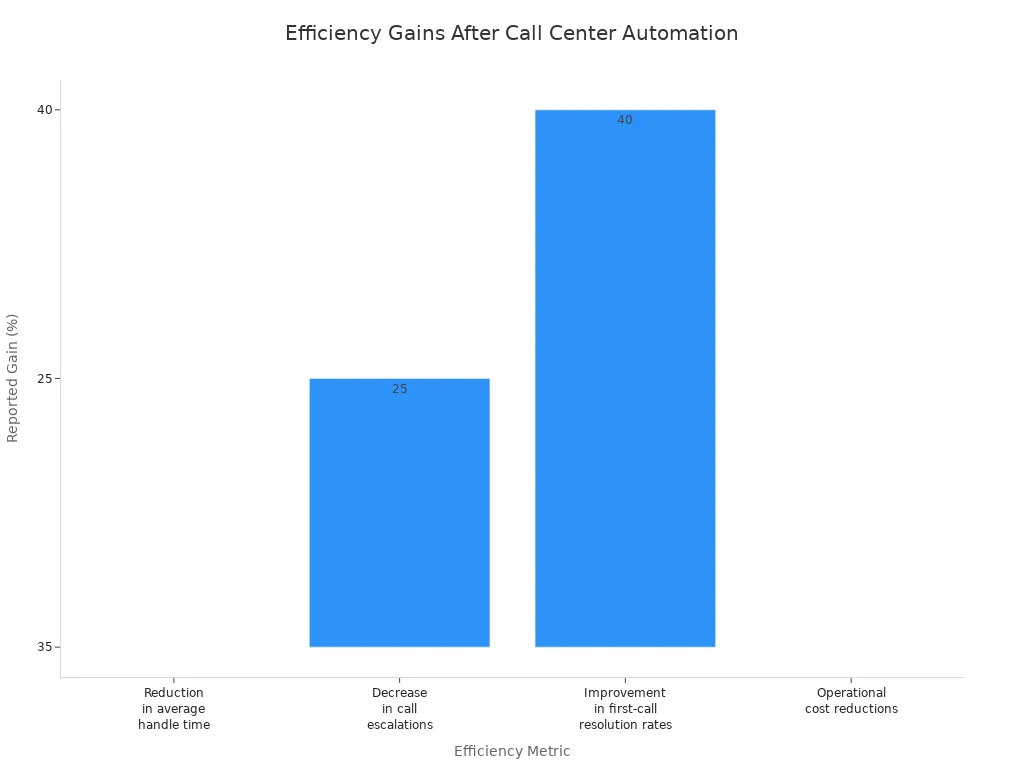
Sobot’s solutions deliver up to a 400% boost in productivity and save up to 2.5 billion annual hours for clients. These results far exceed industry averages and highlight the strong contact center roi achieved through Sobot’s advanced automation. Automated scheduling and workload management optimize agent availability, prevent burnout, and reduce the need for overtime. AI-powered analytics provide real-time insights, enabling managers to make quick decisions and personalize service.
- Interactive Voice Response (IVR) systems enable self-service, deflecting routine calls and reducing agent workload.
- Automated call routing and ticket management reduce manual errors and response times.
- Automation decreases the need for additional staffing, lowering operational costs and supporting cost savings.
Customer satisfaction scores typically improve after implementing automation. Brands using AI-supported customer experience have seen sentiment ratings increase by over 57%. Sobot’s clients, such as Agilent, report a 95% customer satisfaction score after deploying omnichannel automation. This improvement in service quality further strengthens contact center roi and supports long-term revenue growth.
Automation in call centers is not just about reducing operational expenses. It is about improving efficiency, increasing revenue, and delivering a superior customer experience—all of which drive a high roi.
Effective Ways to Improve Contact Center ROI
Sobot Product Features
Sobot delivers a comprehensive suite of automation features designed to maximize contact center roi and drive revenue growth. The platform’s AI-powered call centers stand out for their reliability and advanced technology. Sobot’s Voice/Call Center solution maintains 99.99% uptime, ensuring businesses avoid costly downtime and maintain consistent service. The system integrates easily with CRM and management tools, which speeds up deployment and reduces operational friction.
A unified agent workspace allows staff to manage calls, collaborate, and access customer data in one place. This setup increases reception efficiency by 48%. Sobot’s AI-powered Voicebot uses natural speech analysis and seamless human handoff, reducing agent workload and improving customer interaction. Intelligent IVR and smart call routing direct customers to the right agent, which leads to faster response times and higher first-contact resolution rates. The platform also supports bulk outbound task automation, enabling efficient lead assignment and progression.
Sobot’s real-time monitoring and analytics dashboards provide actionable insights into call duration, queue times, and agent performance. These tools enable proactive management and continuous improvement, which are essential for optimizing contact center roi and supporting revenue generation. The platform offers global phone number availability, expanding market reach and supporting international operations.
| Feature | Description / Benefit | Impact on ROI / Metrics |
|---|---|---|
| AI Call Center Solution | Highly stable with 99.99% uptime | Ensures reliable service, reducing downtime costs |
| CRM & Tech Integration | Easy and fast integration with CRM and management systems | Speeds deployment, reduces operational friction |
| All-in-One Agent Workspace | Unified workspace for agents to manage calls and collaborate | Increased reception efficiency by 48% |
| Average Handle Time Reduction | Streamlined processes and AI assistance | 41% reduction, lowering operational costs |
| First-Contact Resolution Rate | Improved issue resolution on first contact | 54% improvement, enhancing customer satisfaction |
| Intelligent IVR & Call Routing | Customizable IVR menus and smart routing to appropriate agents | Faster response times, better customer experience |
| Call Recording & Monitoring | Enables compliance and quality control | Supports training and legal requirements |
| Bulk Outbound Task Automation | Automated lead assignment and task progression | Improves sales efficiency and agent productivity |
| AI-Powered Voicebot | Natural speech analysis and seamless human handoff | Reduces agent workload, improves customer interaction |
| Global Phone Number Availability | Access to phone numbers in over 100 countries | Expands market reach and supports global operations |
| Real-Time Monitoring & Analytics | Dashboards and alerts for key metrics like call duration and queue time | Enables proactive management and continuous improvement |
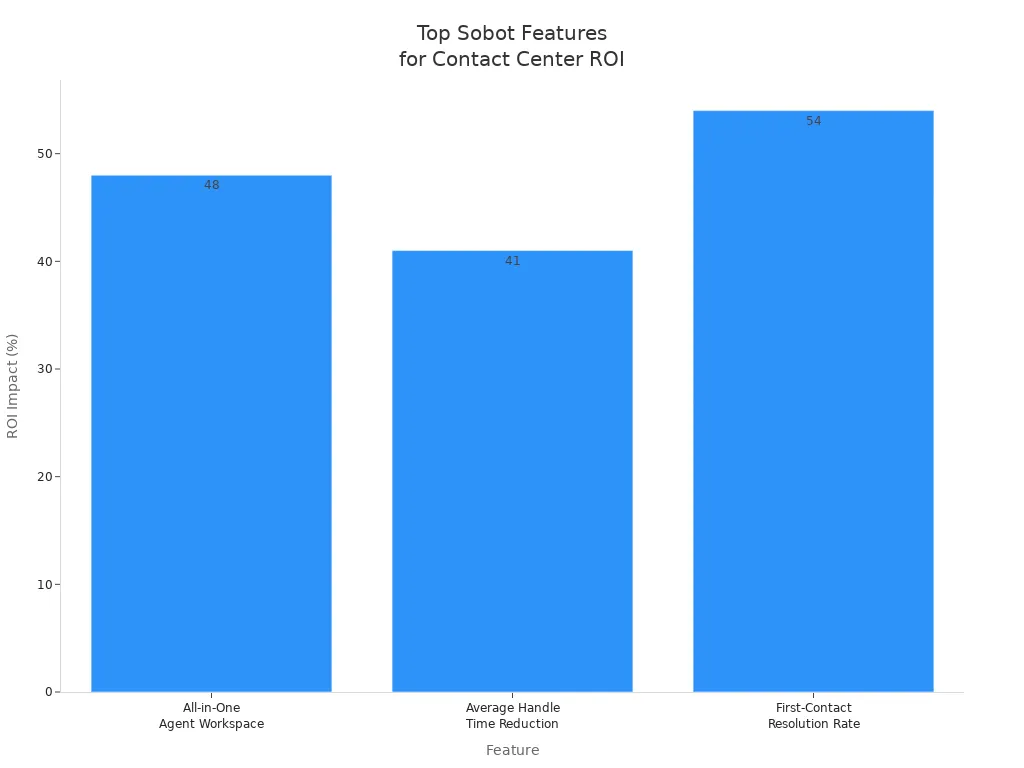
Sobot’s automation features help organizations achieve rapid ai roi by reducing average handle time by 41% and improving first-contact resolution by 54%. These improvements directly impact operational costs and customer satisfaction, which are critical drivers of contact center roi and revenue.
Best Practices
Organizations seeking effective ways to improve contact center roi should follow proven best practices. These steps help maximize the value of automation investments and support sustainable revenue growth.
- Start with high-impact use cases. Focus on automating routine, high-volume interactions such as account inquiries or password resets. This approach delivers immediate cost savings and efficiency gains.
- Scale gradually. Master one or two channels before expanding to a full omnichannel strategy. This method ensures smooth adoption and minimizes disruption.
- Provide comprehensive training. Equip agents with the skills needed to work alongside AI tools. Well-trained staff can leverage automation features to improve customer retention and revenue generation.
- Monitor and optimize performance. Use analytics dashboards to track resolution times, customer satisfaction, and cost per interaction. Regular reviews help identify areas for improvement and support continuous ai roi optimization.
- Engage stakeholders early. Involve key decision-makers and frontline staff in planning and rollout. Early engagement ensures buy-in and smooth transition.
- Leverage feedback loops. Collect input from agents and customers to refine automation features and workflows. Feedback-driven improvements enhance both customer experience and contact center roi.
- Pilot test new features. Roll out updates to small teams before full deployment. This approach allows organizations to address issues quickly and avoid large-scale disruptions.
- Ensure seamless integration. Connect automation tools with existing CRM, telephony, and business systems. Unified data and workflows support better decision-making and revenue growth.
- Invest in change management. Support staff through training and organizational transformation. Successful change management increases adoption rates and maximizes ai roi.
- Continuously optimize quality. Monitor service standards and make adjustments as needed. High-quality service supports customer retention and long-term revenue.
Organizations that follow these best practices often achieve 300-500% roi within 18-24 months and see 80-90% higher implementation success rates.
Real-world examples show the impact of these strategies. A telecommunications provider reduced call handling time by 30% and improved first-call resolution by 20% after implementing AI-driven automation. A global retail chain cut operational costs by 40%, demonstrating the direct link between automation, contact center roi, and revenue.
Metrics
Tracking the right metrics is essential for measuring and improving contact center roi. Decision-makers should focus on both financial and operational indicators to capture the full impact of automation.
- Cost Per Interaction (CPI): Measures the average cost to handle each customer inquiry. Lower CPI indicates higher efficiency and better roi.
- Average Handle Time (AHT): Tracks the time agents spend resolving issues. Reduced AHT signals improved processes and supports revenue growth.
- First-Call Resolution (FCR): Shows the percentage of issues resolved on the first contact. High FCR rates, often above 95% with advanced automation, reflect strong operational performance and customer satisfaction.
- Customer Satisfaction Score (CSAT): Gauges overall customer happiness with service. Higher CSAT scores correlate with increased customer retention and revenue generation.
- Net Promoter Score (NPS): Measures customer willingness to recommend the company. High NPS supports long-term revenue and brand loyalty.
- Agent Productivity: Assesses how efficiently agents handle interactions. Improved productivity leads to lower costs and higher contact center roi.
- Automation Rate: Indicates the percentage of interactions handled by AI or automated systems. Higher automation rates drive down costs and free agents for complex tasks.
- AI-Specific Metrics: Includes natural language understanding (NLU) accuracy and automation coverage for Level 1 and Level 2 queries. These metrics help assess ai roi and the effectiveness of automation features.
- Revenue Impact: Tracks increases in conversion rates, upselling, and customer lifetime value. Direct revenue gains highlight the financial benefits of automation.
- Customer Effort Score: Measures how easy it is for customers to resolve issues. Lower effort scores improve satisfaction and support revenue growth.
Organizations should use advanced analytics tools, such as predictive analytics and customer journey analytics, to identify trends and opportunities for further improvement. Regular roi assessment cycles and benchmarking against industry standards help validate progress and guide corrective actions.
Monitoring these metrics enables continuous optimization, measurable roi improvements, and sustained revenue growth.
By leveraging Sobot’s robust analytics and reporting capabilities, organizations can track these key metrics in real time. This approach ensures that every automation investment delivers maximum contact center roi and supports ongoing revenue generation.
Real-World Results
Case Study: Agilent
Agilent, a leader in life sciences and diagnostics, partnered with Sobot to transform its customer service operations. The company faced high inquiry volumes and needed to improve efficiency and reduce costs. After deploying Sobot’s omnichannel automation, Agilent achieved a sixfold increase in efficiency and a 25% reduction in operational costs. Customer satisfaction reached 95%. The AI-powered chatbot resolved most routine inquiries, freeing agents to focus on complex issues. The collaboration also led to $19.5 million in real estate savings and $4.9 million in operational expense reductions within seven months. Agilent consolidated its global real estate footprint by 2.6 million square feet, all while maintaining business continuity and high customer satisfaction.
| Outcome Category | Details |
|---|---|
| Efficiency | 6x increase in customer service efficiency |
| Cost Reduction | 25% decrease in operational costs |
| Customer Satisfaction | 95% CSAT achieved |
| Real Estate Savings | $19.5 million saved through consolidation |
| Operational Expense Savings | $4.9 million saved in seven months |
Sobot’s automation enabled Agilent to optimize resources, improve agent morale, and deliver consistent service quality. The results highlight the strong roi and financial returns possible with intelligent automation.
Payback Periods
Organizations that invest in call center automation often see rapid roi. Many achieve payback in weeks or months, not years. For example, customer service ticket routing automation typically delivers payback in about 12.4 days, with an average roi of 423% at 30 days. Broader automation projects, such as AI-powered voicebots and omnichannel solutions, usually reach payback within three to six months. A $150,000 investment can generate $400,000 in annual savings, resulting in a 167% roi. These fast returns make automation attractive for companies seeking to boost revenue and efficiency.
| Automation Use Case | Typical Payback Period | Average ROI at 30 Days | Implementation Time | Success Rate |
|---|---|---|---|---|
| Ticket Routing | 12.4 days | 423% | 5-10 days | 87% |
| High-Impact Automation | 3-6 months | 167% (annualized) | Under 5 months | — |
Companies using Sobot’s solutions report even faster payback, especially when automating high-volume, repetitive tasks. These results demonstrate that automation not only improves efficiency but also delivers measurable revenue gains and customer satisfaction improvements.
Lessons Learned
Organizations have learned several key lessons from implementing call center automation:
- Personalization increases customer satisfaction and loyalty by recognizing caller history and preferences.
- Automation reduces operational costs and saves time by streamlining workflows like ticket creation and call logging.
- Empowering agents with the right tools and training maximizes roi and improves agent morale.
- Continuous monitoring and analysis of performance data help identify bottlenecks and drive ongoing optimization.
- Selecting automation tools that align with business needs ensures successful integration and adoption.
- Ongoing training and support enable staff to fully utilize automation capabilities.
- Planning for exceptions and fallback procedures maintains service quality during unexpected events.
Companies that follow these best practices see higher customer satisfaction, improved efficiency, and stronger revenue growth. Sobot’s clients report that AI-powered agents handle over 50% of customer interactions, resolve most Level 1 issues, and boost outbound marketing sales by more than 30%. These outcomes reinforce the value of automation in delivering rapid roi and sustainable financial returns.
Risks and Considerations
Integration
Integration remains a top concern for any call center moving toward automation. Many organizations face challenges when connecting new automation tools with existing systems like CRM, billing, or practice management platforms. Poor integration can increase workload instead of reducing it. Teams often struggle when automation does not align with their daily workflows. Early involvement of IT teams and choosing solutions with flexible APIs help avoid these issues. Sobot’s call center platform offers seamless integration with popular CRM and business management systems, reducing complexity and supporting a smooth transition. Companies should always prioritize the user experience and select technology partners that fit well with their current systems. This approach prevents workflow disruptions and ensures the call center operates efficiently.
Tip: Involve IT teams early and select automation tools with proven compatibility to avoid integration headaches.
Change Management
Change management plays a critical role in successful call center automation. Employees may resist new technology due to fear of job loss or unfamiliar workflows. To address this, organizations should secure executive sponsorship and assemble a skilled change management team. Comprehensive training and clear communication help staff adapt to new processes. Breaking changes into smaller steps, or microchanges, makes adoption easier. Sobot supports clients with onboarding resources and ongoing support, helping teams adjust smoothly. Companies should use multiple communication channels, such as team meetings and Q&A sessions, to keep everyone informed. Recognizing employee achievements and providing real-time feedback also boost engagement and reduce resistance.
- Secure leadership support and resources.
- Provide hands-on training and ongoing learning.
- Communicate benefits and progress regularly.
- Break changes into manageable steps.
- Monitor adoption and adjust as needed.
Quality Control
Automation can improve quality control in the call center by increasing accuracy and consistency. Automated systems cover every interaction, reducing bias and providing real-time insights. However, challenges can arise if integration is poor or if employees do not trust the technology. To maintain high standards, organizations should choose quality assurance tools that integrate easily with their call center systems. Sobot’s analytics and monitoring features help managers track key metrics like customer satisfaction and first-call resolution. Regular reviews and pilot programs demonstrate the value of automation and build trust among staff. Companies should always keep data up to date and provide clear privacy options for customers.
Common pitfalls include over-automating customer interactions, ignoring personalization, and failing to monitor system performance. Organizations can avoid these issues by:
- Automating only simple, repetitive tasks.
- Ensuring easy escalation to human agents.
- Using AI that adapts to customer context.
- Regularly reviewing and updating automated workflows.
Note: Balance automation with human support to maintain a personal touch and avoid customer frustration.
Automation stands out as a strategic investment for call centers in 2025. Companies see real gains in customer satisfaction, cost savings, and improved customer experience. AI-powered automation delivers 24/7 support, faster response times, and higher customer satisfaction. Sobot’s solutions help organizations boost customer experience and maximize investment returns. Leaders should follow proven steps to track ROI and enhance customer satisfaction. Explore Sobot’s offerings or contact their team to see how automation can transform your customer experience and deliver a strong investment outcome.
FAQ
What is the typical ROI for call center automation in 2025?
Companies report an average contact center roi of 300% to 500% within the first year. Sobot’s clients often achieve payback in under six months. Industry data shows automation can reduce costs by up to 70% (Gartner).
How does Sobot help improve contact center roi?
Sobot’s Voice/Call Center and Omnichannel Solutions automate routine tasks, unify customer data, and provide real-time analytics. These features increase agent productivity and reduce operational costs. Many organizations see a 25% cost reduction and a sixfold efficiency boost after implementation.
Tip: Sobot’s unified workspace streamlines workflows and supports rapid ROI.
What automation features drive the highest ROI?
AI-powered voicebots, intelligent IVR, and automated ticketing deliver the strongest contact center roi. Sobot’s platform offers 99.99% uptime, global phone number access, and seamless CRM integration. These features help companies reduce average handle time by 41% and improve first-contact resolution by 54%.
Is automation suitable for small businesses?
Small businesses benefit from automation by lowering costs and improving customer experience. Sobot’s SaaS model makes advanced features affordable and easy to deploy. Even small teams can achieve strong roi and scale operations quickly.
| Business Size | Typical ROI | Sobot Solution |
|---|---|---|
| Small | 200%+ | SaaS Call Center |
| Medium | 300-500% | Omnichannel Platform |
What metrics should companies track to measure contact center roi?
Key metrics include cost per interaction, average handle time, first-call resolution, customer satisfaction (CSAT), and automation rate. Sobot’s analytics dashboard helps managers monitor these metrics in real time, ensuring continuous improvement and maximum roi.
Note: Tracking these metrics supports data-driven decisions and sustained contact center roi.
See Also
Understanding The Efficient Functioning Of Call Center Automation
Best Ten Call Center Analytics Tools To Use In 2024
Comprehensive Review Of Leading Contact Center Solutions 2024
Discover The Leading Cloud Contact Centers For 2025
Evaluating Artificial Intelligence Solutions For Enterprise Call Centers
